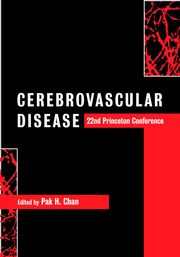Book contents
- Frontmatter
- Contents
- List of contributors
- Preface
- Acknowledgments
- Part I Special lectures
- Part II Oxidative stress
- 3 Peroxynitrite and injury to the vasculature and central nervous system in stroke and neurodegeneration
- 4 Interaction between inducible nitric oxide and cyclooxygenase-2 in ischemic brain injury
- 5 Mechanisms of ischemic tolerance
- 6 Clinically tolerated NMDA receptor antagonists and newly cloned NMDA receptor subunits that mimic them
- Part III Apoptosis
- Part IV Hot topics
- Part V Hemorrhage, edema and secondary injury
- Part VI Inflammation
- Part VII Gene transfer and therapy
- Part VIII Neurogenesis and plasticity
- Part IX Magnetic resonance imaging in clinical stroke
- Part X Risk factors, clinical trials and new therapeutic horizons
- Index
- Plate section
5 - Mechanisms of ischemic tolerance
from Part II - Oxidative stress
Published online by Cambridge University Press: 02 November 2009
- Frontmatter
- Contents
- List of contributors
- Preface
- Acknowledgments
- Part I Special lectures
- Part II Oxidative stress
- 3 Peroxynitrite and injury to the vasculature and central nervous system in stroke and neurodegeneration
- 4 Interaction between inducible nitric oxide and cyclooxygenase-2 in ischemic brain injury
- 5 Mechanisms of ischemic tolerance
- 6 Clinically tolerated NMDA receptor antagonists and newly cloned NMDA receptor subunits that mimic them
- Part III Apoptosis
- Part IV Hot topics
- Part V Hemorrhage, edema and secondary injury
- Part VI Inflammation
- Part VII Gene transfer and therapy
- Part VIII Neurogenesis and plasticity
- Part IX Magnetic resonance imaging in clinical stroke
- Part X Risk factors, clinical trials and new therapeutic horizons
- Index
- Plate section
Summary
Introduction
Preconditioning to ischemic tolerance is a phenomenon in which brief episodes of a subtoxic insult induce a robust protection against a lethal ischemic insult. The beneficial effects of preconditioning were first demonstrated in the heart. It is now clear that preconditioning can induce ischemic tolerance in a variety of organ systems, including the brain. Preconditioning stimuli are quite diverse, ranging from transient ischemic episodes, spreading depression, hypoxia, anoxia, chemical inhibition of oxidative phosphorylation exposure to excitotoxins and cytokines.
There are two temporally and mechanistically distinct types of protection afforded by preconditioning stimuli; acute and delayed. Acute preconditioning is protein synthesis independent, mediated by post-translational protein modifications. Acute preconditioning is short lived, of the order of minutes to hours. Delayed preconditioning requires new protein synthesis and is sustained for days to weeks. Elucidation of the molecular mechanisms that are involved in preconditioning and ischemic tolerance might lead to the identification of drugs that mimic this protective response and improve the prognosis of patients at risk for ischemic injury.
Neuronal ischemic preconditioning was first reported by Kitagawa and coworkers in gerbils subjected to sublethal transient global ischemia. CA1 hippocampal neurons exhibited reduced neuronal death after a severe ischemic insult 24 to 48 hours later. In the brain, ischemic preconditioning is mediated largely through the activation of the N-methyl-d-aspartate (NMDA) receptors through increases in intracellular calcium and requires new protein synthesis.
- Type
- Chapter
- Information
- Cerebrovascular Disease22nd Princeton Conference, pp. 58 - 71Publisher: Cambridge University PressPrint publication year: 2002

